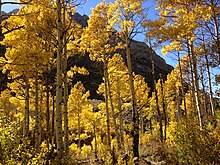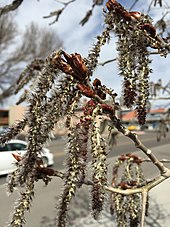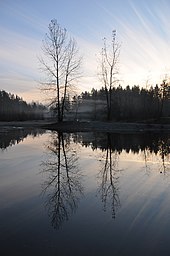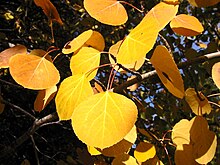Populus tremuloides
| Quaking aspen | |
|---|---|

| |
| Quaking aspen grove in Lamoille Canyon, Nevada, U.S. | |
| Scientific classification | |
| Kingdom: | Plantae |
| Clade: | Tracheophytes |
| Clade: | Angiosperms |
| Clade: | Eudicots |
| Clade: | Rosids |
| Order: | Malpighiales |
| Family: | Salicaceae |
| Genus: | Populus |
| Section: | Populus sect. Populus |
| Species: | P. tremuloides
|
| Binomial name | |
| Populus tremuloides | |

| |
Populus tremuloides is a
Populus tremuloides is the most widely distributed tree in North America, being found from Canada to central Mexico.
Description


The quaking aspen is a tall, fast-growing tree, usually 15–18 meters (50–60 ft) at maturity, with a trunk 25 centimeters (10 in) in diameter;[7] records are 36.5 m (119 ft 9 in) in height and 1.37 m (4 ft 6 in) in diameter. The bark is relatively smooth, whitish (light green when young),[7] and is marked by thick black horizontal scars and prominent black knots. Parallel vertical scars are tell-tale signs of elk, which strip off aspen bark with their front teeth.
The
Aspens are
Quaking aspen grows more slowly in the dry conditions of western North America than it does in the more humid east and also lives longer—ages of 80–100 years are typical,[7] with some individuals living 200 years; the root system can live much longer.[7] In the east, stands decay faster, sometimes in 60 years or less depending on the region.
Name
The quaking or trembling of the leaves that is referred to in the common names is due to the flexible flattened petioles.[8] The specific epithet, tremuloides, evokes this trembling behavior and can be literally translated as "like (Populus) tremula", the European trembling aspen.[citation needed]
Distribution

Quaking aspen occurs across Canada in all provinces and territories, with the possible exception of regions of Nunavut north of the James Bay islands. In the United States, it can be found as far north as the northern foothills of the Brooks Range in Alaska, where road margins and gravel pads provide islands of well-drained habitat in a region where soils are often waterlogged due to underlying permafrost.[9] It occurs at low elevations as far south as northern Nebraska and central Indiana. In the Western United States, this tree rarely survives at elevations lower than 1,500 feet (460 m) due to hot summers experienced below that elevation, and is generally found at 5,000–12,000 feet (1,500–3,700 m).[4]
It grows at high altitudes as far south as Guanajuato, Mexico.[4] It grows in isolated areas in northeastern Mexico as well as Baja California, Jalisco, the State of Mexico, Michoacán, Sinaloa, Sonora, and Veracruz.[10]
Quaking aspen grows in a wide variety of climatic conditions. January and July average temperatures range from −30 °C (−22 °F) and 16 °C (61 °F) in the
In the
Ecology
Quaking aspen propagates itself primarily through root sprouts, and extensive clonal colonies are common. Each colony is its own clone, and all trees in the clone have identical characteristics and share a single root structure. A clone may turn color earlier or later in the fall than its neighboring aspen clones. Fall colors are usually bright tones of yellow; in some areas, red blushes may be occasionally seen. As all trees in a given clonal colony are considered part of the same organism, one clonal colony, named Pando, is considered the heaviest[13] and oldest[14] living organism on the planet. Pando spans across 43 hectares, weighs six million kilograms, and is perhaps 80,000 years old.[15] Aspens do produce seeds, but seldom grow from them. Pollination is inhibited by the fact that aspens are either male or female, and large stands are usually all clones of the same sex. Even if pollinated, the small seeds (three million per pound) are only viable a short time as they lack a stored food source or a protective coating.[16]
The buds and bark supply food for snowshoe hares, moose, black bears, cottontail rabbits, porcupines, deer, grouse, and mountain beavers. The shoots are eaten by sheep, goats, and cattle. Sheep and goats also browse the foliage, as do game animals including elk.[17][18] Grouse and quail especially eat the buds in winter. Mammals such as beavers and rabbits eat the bark, foliage, and buds.[17] Beavers also store aspen logs for winter food. Other animals nest in aspen groves.[7] The leaves of the quaking aspen and other species in the genus Populus serve as food for caterpillars of various moths and butterflies.[19] Quaking aspen trees also serve as hosts to certain damaging insects such as the large aspen tortrix.[20]
Dieback


Increased mortality in trembling aspen stands have been reported since the early 1990s across North America.[21] As this accelerated in 2004, a debate over causes began. This increased dieback has been linked to multiple stressors, such as defoliation by the forest tent caterpillar (Malacosoma disstria), wood-boring beetles such as the poplar borer (Saperda calcarata) and the bronze poplar borer (Agrilus liragus), and fungal disturbances such as those by the Cytospora canker (Valsa sordida).[22][21]
Many areas of the Western US have experienced increased diebacks which are often attributed to ungulate grazing and
Increased mortality has also been linked in turn to climate change. Thaw-freeze events and light snowfall in late winter as a result of increased temperatures has led to increased dieback in Southern and Western Canada.[21] Furthermore, climate records show that historically, most periods of aspen decline have been paired with periods of severe drought, which has worsened in recent years due to a changing climate.[25] Many stands of aspen that have been affected by climate change in recent years have poor regeneration potential, leading to concerns of widespread loss of aspen cover in the future.[25]
Because of vegetative regeneration by aspen, where an entire group of trees are essentially clones, there is a concern that something that hits one will eventually kill all of the trees, presuming they share the same vulnerability. A conference was held in Utah in September 2006 to share notes and consider investigative methodology.[26]
Uses
Aspen bark contains a substance that was extracted by indigenous North Americans and European settlers of the western U.S. as a quinine substitute.[16]
Like other poplars, aspens make poor
Aspen wood is used for pulp products[7] (its main application in Canada) such as books, newsprint, and fine printing paper. It is especially good for panel products such as oriented strand board and waferboard. It is light in weight and is used for furniture, boxes and crates, core stock in plywood, and wall panels.[28]
Culture
The quaking aspen is the state tree of Utah.[29]
See also
- Pando, an exceptionally large clonal colony of P. tremuloides determined to be a single male tree
- Largest organisms
References
- . Retrieved 20 September 2021.
- ^ Bryce Canyon National Park Service
- ^ a b c "Populus tremuloides". Germplasm Resources Information Network. Agricultural Research Service, United States Department of Agriculture.
- ^ a b c d e Perala, D. A. (1990). "Populus tremuloides". In Burns, Russell M.; Honkala, Barbara H. (eds.). Hardwoods. Silvics of North America. Vol. 2. Washington, D.C.: United States Forest Service (USFS), United States Department of Agriculture (USDA) – via Southern Research Station.
- ^ a b c d e "technology transfer fact sheet: Populus spp" (PDF). Forest Products Laboratory: R&D USDA. Madison, Wisconsin: United States Department of Agriculture Forest Service, Center for Wood Anatomy Research. Retrieved 20 September 2010.
- ^ "Aspen, Quaking (Populus tremuloides)". Arbor Day Foundation.
- ^ OCLC 1141235469.
- ^ "Populus tremuloides – Purdue Arboretum Explorer". Retrieved 2023-11-16.
- ISSN 1923-1245.
- ^ Hassler, Michael (3 January 2024). "World Plants". Synonymic Checklist and Distribution of the World Flora. Version 18.3. Retrieved 10 January 2024.
- OCLC 25708726.
- OCLC 23653610.
- S2CID 87362686.
- ISSN 2693-2407.
- .
- ^ a b Ewing, Susan. The Great Alaska Nature Factbook. Portland: Alaska Northwest Books, 1996.
- ^ ISBN 0-394-73127-1.
- Bonanza Books. p. 320.
- ISSN 0378-1127.
- OCLC 36695777.
- ^ ISSN 0045-5067.
- ISSN 0378-1127.
- ^ Haskins; et al. (2007). "Impact of fire suppression on aspen populations". Forestry and Wildlife Management. 19 (3): 54–57.
- .
- ^ ISSN 0378-1127.
- ^ Kelley, Katie (26 September 2006). "Emblem of the West Is Dying, and No One Can Figure Out Why". The New York Times.
- ^ https://www.fs.usda.gov/nrs/pubs/LSFES_aspen_reports/1947_lakestates_aspen_15.pdf
- ^ https://www.fpl.fs.usda.gov/documnts/usda/amwood/217aspen.pdf
- ^ "S.B. 41 State Tree Change". Utah State Legislature.
External links
- US Forest Service Fire Effects Information System: Populus tremuloides
- Alberta Forest Genetic Resources Council: Populus tremuloides
- Interactive Distribution Map for Populus tremuloides Archived 2015-11-13 at the Wayback Machine
- Farrar, John Laird. Trees In Canada. Fitzhenry and Whiteside, 1995
- Hickman, James C., ed. The Jepson Manual: Higher Plants of California, ISBN 0520082559. University of California Press, 1993.
- "Populus tremuloides". Plants for a Future.

